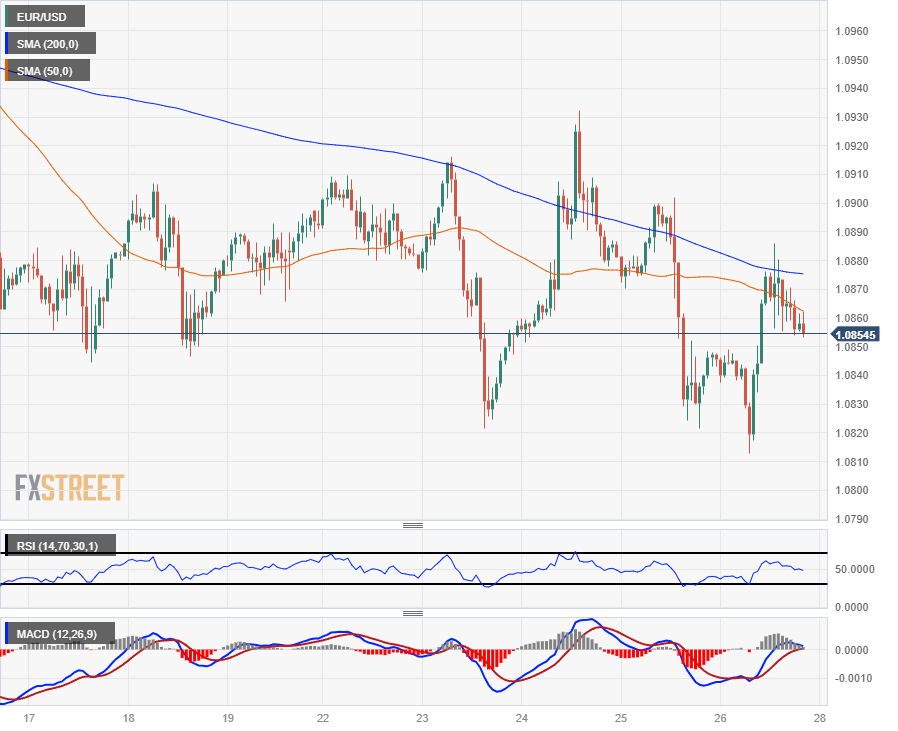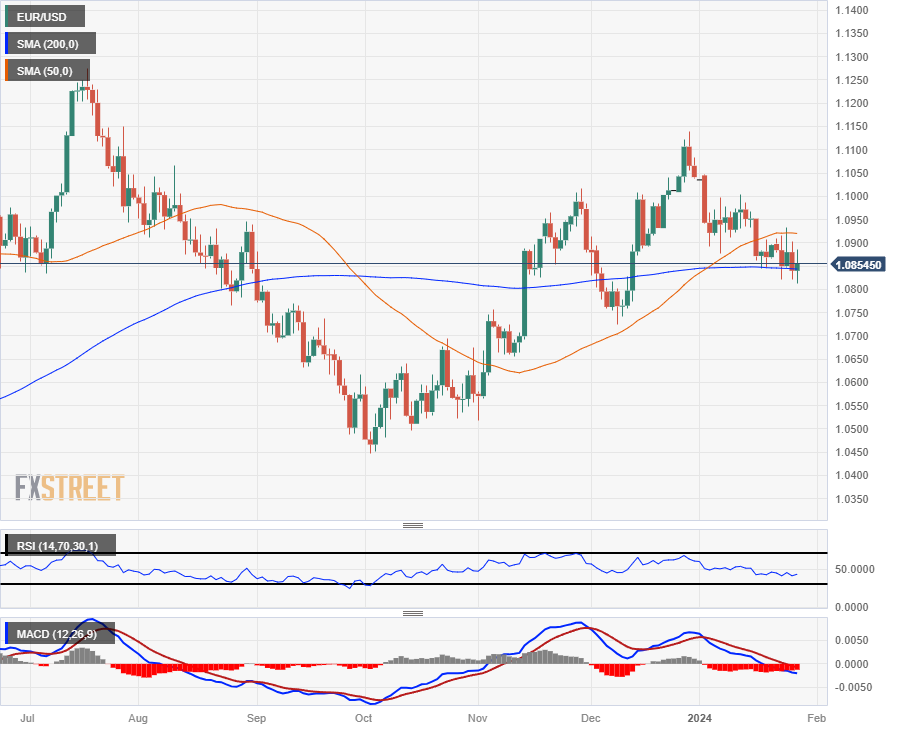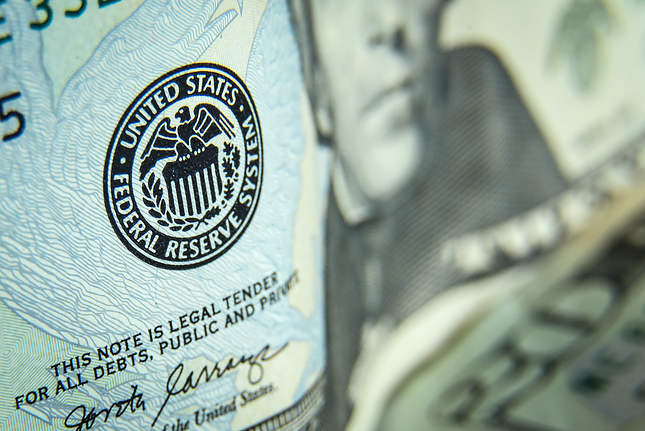- EUR/USD reclaims territory near 1.0880 after drop into 1.0820.
- German Consumer Confidence declined to 11-month low.
- US PCE inflation eased more than expected, but spending remained high.
EUR/USD recovered recent losses on Friday, recovering back into familiar technical levels. Still, overall gains remained limited after German Consumer Confidence backslid to almost a one-year low as economic conditions in Europe remain tepid at best.
US Personal Consumption Expenditure (PCE) Price Index inflation figures eased more than expected, but further gains in December’s Personal Spending alongside an unexpected uptick in Pending Home Sales trimmed rate cut expectations. With the US domestic economy continuing to bump along at a healthy clip, market hopes for early and deep rate cuts from the Federal Reserve continue to wilt.
Daily digest market movers: EUR/USD pares losses despite determined Greenback
- EUR/USD slipped into multi-week lows early Friday after German Gfk Consumer Confidence in February declined to an 11-month low of -29.7 versus the forecasted improvement from -25.1 to -24.5.
- The US Dollar broadly recovered after US YoY Core PCE Price Index figures in December eased to 2.9% from the forecast of 3.0%, previous 3.2%.
- Despite the easing in inflation, US Personal Spending and Pending Home Sales both stepped higher.
- Personal Spending rose 0.7% in December versus the 0.4% forecast, with the previous month’s print getting revised to 0.4% from 0.2%.
- US Pending Home Sales climbed 8.3% in December compared to the expected rebound to 1.5% from the previous month’s 0.3% decline (revised down from 0.0%).
- Next week brings European Gross Domestic Product (GDP) numbers on Tuesday, with the next high-impact rate call from the US Federal Reserve (Fed) slated for Wednesday.
- Euro area Q4 GDP is expected to print at -0.1%, in line with the previous figure as the pan-European economy lags in stagnation.
- Federal Reserve expected to hold rates steady in January, CME FedWatch Tool suggests markets pivoted to betting on the first rate cut in May after rate bets shifted post-PCE print.
Euro price this week
The table below shows the percentage change of Euro (EUR) against listed major currencies this week. Euro was the strongest against the New Zealand Dollar.
| USD | EUR | GBP | CAD | AUD | JPY | NZD | CHF | |
| USD | 0.35% | -0.03% | 0.17% | 0.30% | 0.03% | 0.43% | -0.53% | |
| EUR | -0.35% | -0.47% | -0.15% | -0.10% | -0.33% | 0.12% | -0.83% | |
| GBP | 0.05% | 0.44% | 0.24% | 0.33% | 0.06% | 0.47% | -0.51% | |
| CAD | -0.14% | 0.18% | -0.17% | 0.20% | -0.10% | 0.31% | -0.66% | |
| AUD | -0.30% | 0.06% | -0.38% | -0.19% | -0.24% | 0.12% | -0.81% | |
| JPY | -0.02% | 0.32% | -0.04% | 0.14% | 0.34% | 0.44% | -0.48% | |
| NZD | -0.43% | -0.10% | -0.47% | -0.31% | -0.11% | -0.43% | -0.99% | |
| CHF | 0.41% | 0.73% | 0.50% | 0.65% | 0.83% | 0.48% | 0.95% |
The heat map shows percentage changes of major currencies against each other. The base currency is picked from the left column, while the quote currency is picked from the top row. For example, if you pick the Euro from the left column and move along the horizontal line to the Japanese Yen, the percentage change displayed in the box will represent EUR (base)/JPY (quote).
Technical Analysis: EUR/USD gets pushed back into technical barriers, but topside limited
EUR/USD hit a multi-week low of 1.0813 early Friday before a rebound into the 200-hour Simple Moving Average (SMA) near 1.0880. Dollar bets continue to weigh on USD pairs, keeping EUR/USD leaning toward a near-term middle around 1.0850.
Despite intraday tests into the low side, EUR/USD is set to continue languishing in an ongoing congestion pattern between the 50-day and 200-day SMAs at 11.0925 and 1.0850, respectively. The pair has been trapped within the consolidation pattern since dropping from December’s peak near 1.1140.
EUR/USD Hourly Chart
EUR/USD Daily Chart
Euro FAQs
What is the Euro?
The Euro is the currency for the 20 European Union countries that belong to the Eurozone. It is the second most heavily traded currency in the world behind the US Dollar. In 2022, it accounted for 31% of all foreign exchange transactions, with an average daily turnover of over $2.2 trillion a day.
EUR/USD is the most heavily traded currency pair in the world, accounting for an estimated 30% off all transactions, followed by EUR/JPY (4%), EUR/GBP (3%) and EUR/AUD (2%).
What is the ECB and how does it impact the Euro?
The European Central Bank (ECB) in Frankfurt, Germany, is the reserve bank for the Eurozone. The ECB sets interest rates and manages monetary policy.
The ECB’s primary mandate is to maintain price stability, which means either controlling inflation or stimulating growth. Its primary tool is the raising or lowering of interest rates. Relatively high interest rates – or the expectation of higher rates – will usually benefit the Euro and vice versa.
The ECB Governing Council makes monetary policy decisions at meetings held eight times a year. Decisions are made by heads of the Eurozone national banks and six permanent members, including the President of the ECB, Christine Lagarde.
How does inflation data impact the value of the Euro?
Eurozone inflation data, measured by the Harmonized Index of Consumer Prices (HICP), is an important econometric for the Euro. If inflation rises more than expected, especially if above the ECB’s 2% target, it obliges the ECB to raise interest rates to bring it back under control.
Relatively high interest rates compared to its counterparts will usually benefit the Euro, as it makes the region more attractive as a place for global investors to park their money.
How does economic data influence the value of the Euro?
Data releases gauge the health of the economy and can impact on the Euro. Indicators such as GDP, Manufacturing and Services PMIs, employment, and consumer sentiment surveys can all influence the direction of the single currency.
A strong economy is good for the Euro. Not only does it attract more foreign investment but it may encourage the ECB to put up interest rates, which will directly strengthen the Euro. Otherwise, if economic data is weak, the Euro is likely to fall.
Economic data for the four largest economies in the euro area (Germany, France, Italy and Spain) are especially significant, as they account for 75% of the Eurozone’s economy.
How does the Trade Balance impact the Euro?
Another significant data release for the Euro is the Trade Balance. This indicator measures the difference between what a country earns from its exports and what it spends on imports over a given period.
If a country produces highly sought after exports then its currency will gain in value purely from the extra demand created from foreign buyers seeking to purchase these goods. Therefore, a positive net Trade Balance strengthens a currency and vice versa for a negative balance.
Information on these pages contains forward-looking statements that involve risks and uncertainties. Markets and instruments profiled on this page are for informational purposes only and should not in any way come across as a recommendation to buy or sell in these assets. You should do your own thorough research before making any investment decisions. FXStreet does not in any way guarantee that this information is free from mistakes, errors, or material misstatements. It also does not guarantee that this information is of a timely nature. Investing in Open Markets involves a great deal of risk, including the loss of all or a portion of your investment, as well as emotional distress. All risks, losses and costs associated with investing, including total loss of principal, are your responsibility. The views and opinions expressed in this article are those of the authors and do not necessarily reflect the official policy or position of FXStreet nor its advertisers. The author will not be held responsible for information that is found at the end of links posted on this page.
If not otherwise explicitly mentioned in the body of the article, at the time of writing, the author has no position in any stock mentioned in this article and no business relationship with any company mentioned. The author has not received compensation for writing this article, other than from FXStreet.
FXStreet and the author do not provide personalized recommendations. The author makes no representations as to the accuracy, completeness, or suitability of this information. FXStreet and the author will not be liable for any errors, omissions or any losses, injuries or damages arising from this information and its display or use. Errors and omissions excepted.
The author and FXStreet are not registered investment advisors and nothing in this article is intended to be investment advice.
Recommended content
Editors’ Picks

AUD/USD appreciates as US Dollar remains subdued after a softer inflation report
The Australian Dollar steadies following two days of gains on Monday as the US Dollar remains subdued following the Personal Consumption Expenditures Price Index data from the United States released on Friday.

USD/JPY consolidates around 156.50 area; bullish bias remains
USD/JPY holds steady around the mid-156.00s at the start of a new week and for now, seems to have stalled a modest pullback from the 158.00 neighborhood, or over a five-month top touched on Friday. Doubts over when the BoJ could hike rates again and a positive risk tone undermine the safe-haven JPY.

Gold downside bias remains intact while below $2,645
Gold price is looking to extend its recovery from monthly lows into a third day on Monday as buyers hold their grip above the $2,600 mark. However, the further upside appears elusive amid a broad US Dollar bounce and a pause in the decline of US Treasury bond yields.

Week ahead: No festive cheer for the markets after hawkish Fed
US and Japanese data in focus as markets wind down for Christmas. Gold and stocks bruised by Fed, but can the US dollar extend its gains? Risk of volatility amid thin trading and Treasury auctions.

Bank of England stays on hold, but a dovish front is building
Bank of England rates were maintained at 4.75% today, in line with expectations. However, the 6-3 vote split sent a moderately dovish signal to markets, prompting some dovish repricing and a weaker pound. We remain more dovish than market pricing for 2025.

Best Forex Brokers with Low Spreads
VERIFIED Low spreads are crucial for reducing trading costs. Explore top Forex brokers offering competitive spreads and high leverage. Compare options for EUR/USD, GBP/USD, USD/JPY, and Gold.